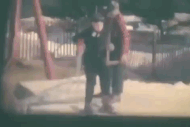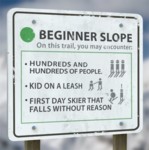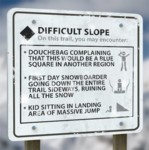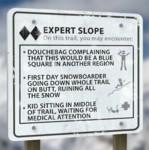Cool Pic from the summit of K. Almost 100 years ago!

Once upon a time in history: Early Killington and tourism
By Karen D. Lorentz posted Jul 25, 2012
Killington was originally settled by families from Connecticut, Massachusetts and Rhode Island. They came to Vermont looking for good, cheap land to farm - largely because their farming methods had depleted soils (due to lack of crop rotation and proper fertilizing) and as families expanded, it was necessary for some of the younger generation to look elsewhere for a place to farm. By 1810 there were 116 inhabitants in Killington and 218,000 in Vermont.
Vermont's settlers set about taming the wilderness by establishing grain and saw mills. The woods were opened up and pushed back, not only to make way for farmland but also to promote a feeling of safety. The forests supplied the logs and boards for homes and wood for furniture, tools, utensils, and heat. Although they were plentiful, logs could only be driven to market via waterways so this industry remained small until 1850 when the railroad made its debut. Then rail transportation hastened the cutting of forests by making possible a major logging industry.
Farming was difficult on the thin soils in mountain towns, but the 1811 introduction of Merino sheep began a profitable industry along with the lumber business. Vermont was 70 to 75 percent clear of trees by the late 1800s. (It reverted back to 70 to 80 percent forested after the demise of the sheep industry.)
As the population of the state quickly grew to 314,120 in 1850, Killington grew slowly and peaked at 578 in 1850. Reflecting what was happening in other hill towns, the statistics of 1840 showed the town had 82 horses, 625 cattle, and 1450 sheep. Oats, wheat, potatoes, maple sugar, hay, and wool were the major crops of the day.
Prosperity was short lived, however. The sheep industry was dealt a blow by the loss of its protective tariff and a subsequent decline in demand for wool triggered a severe economic loss to the state.
To make matters worse, the soils were being depleted from poor agricultural methods, overgrazing by sheep, and the extensive logging, which caused erosion problems. Unrestricted hunting and trapping resulted in scarcer wildlife and even fish were disappearing. By the mid-to-late 1800s, the Green Mountains of Vermont had become a biological wasteland.
To exacerbate matters, disease, storms, and the rugged climate made for a short growing season. Vermonters fled the state - 145,655 natives had left by 1850. The economic downturn compounded the severity of the exodus, and by 1880 Vermont had lost 54 percent of her native population to migration!
From 1850 to 1900, two out of every five Vermonters gave up the struggle and headed for greener pastures. Additionally, many Vermont men died in the Civil War, and those who did return often spread the word about opportunities where the climate was less harsh, the terrain less rugged, and the land more fertile. The railroads and Erie Canal provided an easy and cheap escape route to the beckoning country of the West and Mid-West where the federal government was promoting homesteading at $1.25 per unimproved acre.
Mountain towns were among the most severely affected. (Vermont had 20 towns with an elevation of 1500 feet or more.) They had always presented a harsh environment and constant challenge to their inhabitants, but the reversal of Vermont's economic growth was particularly cruel because their residents had depended so heavily on those jobs that offered subsistence living - sheep raising, farming, logging, hunting, and trapping.
Windham dropped from a population of 1,000 to 150, Stratton from 212 to 72, Searsburg from 1,431 to 84, and Shrewsbury from 1,149 to 464. By 1900 there were 402 people in Killington. The decline continued until 1960 when Killington reached a low of 266 residents!
Enter Tourism
Some "urban" areas in Vermont did prosper in the mid-to-late 1800s. Proctor did well as a marble town, and Rutland was thriving due to the railroad and Howe Scale. From 1850 to 1880 Rutland tripled in population and aside from its good fortune of being a manufacturing and railroad center, it was the recipient of a favorable tourist trade enhanced by surrounding lakes and neighboring peaks.
Ironically, it was at the time when the railroads were making it so easy to leave, that it also became easier for others to visit Vermont and enjoy the cooler Green Mountain summers.
Although the mountain towns suffered greatly from the exodus, many were saved from extinction by a new economic means to survival, tourism. Stagecoach stops became busier, and inns and taverns saw an increasing summer trade even in the more remote and mountainous areas.
Enterprising Vermonters, who were aware of both the economic benefit and the aesthetic challenge offered by visits to nearby mountains, capitalized on the business opportunities and opened hotels both in towns near high peaks and in some cases on them as well.
Additionally, many locals took to enjoying Sunday outings on their neighboring peaks. In Rutland there was an interest in "going up the mountain" as early as 1859. A "horse path" from the Wheelerville section of Mendon up to just below Killington Peak was built by 1860.
Vincent C. Meyerhoffer built a rustic cabin about 300 feet below the Peak in 1860, and playing host to increasing throngs of friends and visitors, enlarged his cabin to a hotel, which opened on June 17 for the 1880 summer season.
Killington's Summit House was more ambitious than the original hotel on Mount Mansfield. It had rooms for 30 to 40 guests, stables, sheds, annexes, and porches and offered hiking, croquet and fishing as well as glorious sunrises and sunsets.
For several years, Meyerhoffer had a booming business with a steady flow of out-of-state tourists as well as dinner and overnight guests from Rutland. Making the ten-mile journey by horse-drawn carriage ride by night to arrive at the hotel at dawn was one of the favorite Rutland pastimes.
Publicists advertised a view from the top "far surpassing in extent and beauty that obtained from any other mountain in Vermont" and even regarded it "more attractive than that from Mount Washington, being less a scene of desolation and of greater pastoral beauty, presenting to the beholder a sea of mountains clothed to their summits with verdure, their sides dotted with nestling lakes and fertile farms."
Some more rugged individuals hiked the 3000 vertical feet from the Wheelerville approach. Many other routes were used or built to get to the peak from other towns with horse, oxen, and foot power popular modes of transportation!
Although the hotel trade on Killington came to an end by 1910, people continued to visit the summit. The late Claude Dewey, a trapper, served as a guide for groups wishing to make the climb just after the hotel fell into disuse. He usually started from West Bridgewater and went up the old Juggernaut Trail.
Treks to the Peak continued to be popular in the 1900s with oxen and horse drawn rides taking some to the base of Killington (K-1 Lodge area), and from there they would hike or snowshoe up to the peak.
"It was for excitement, discovery, and challenge" that they undertook the trip, notes Rutland historian Dawn Hance. Adventure then, as now, was Killington's calling card.
But the townspeople of Killington (formerly known as Sherburne) did not reap the economic benefits of their mountain just yet. That would change with the ski area being developed, and the "new settlers" who would come to town to cast their lot with winter tourism.
We'll trace the town's resurgence and learn what it was like to establish a "mountain community" in talks with "oldies but goodies" in coming weeks.





